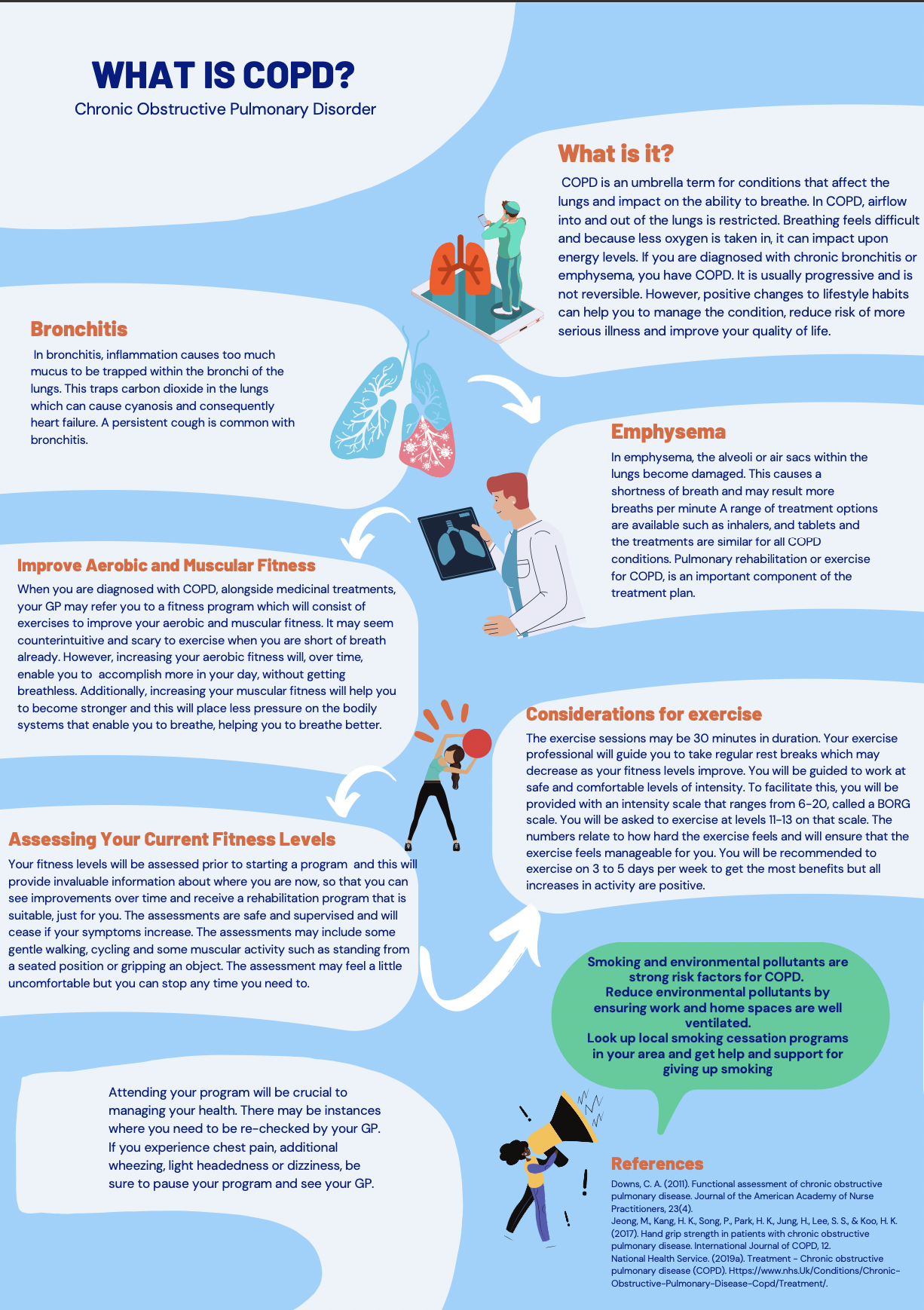Chronic Obstructive Pulmonary Disorder

Click Here For Chronic Obstructive Pulmonary Disorder Leaflet
COPD is an umbrella term for conditions that affect the lungs and impact on the ability to breathe. In COPD, airflow into and out of the lungs is restricted. Breathing feels difficult and because less oxygen is taken in, it can impact upon energy levels. If you are diagnosed with chronic bronchitis or emphysema, you have COPD. It is usually progressive and is not reversible. However, positive changes to lifestyle habits can help you to manage the condition, reduce risk of more serious illness and improve your quality of life.
Female Breast Cancer

Click Here For Female Breast Cancer Leaflet
Cancer is the abnormal or uncontrollable cell growth of cells. The most common type of breast cancer is invasive ductal carcinoma which means the cancer (or abnormal cell growth) begins in the tissues of the milk ducts of the breast. Invasive lobular carcinoma is the second most common type and this is where the cancer begins in the lobules that empty breast milk into the milk ducts. If the cancer has metastasised, it means the cancer has spread to other tissues within the body. Treatments for breast cancer include chemo or radiotherapy or surgery, to remove the lump or the entire breast.
Type II Diabetes Mellitus

Click Here For Type 2 Diabetes Mellitus Leaflet
Type 2 Diabetes involves the pancreas and insulin. When blood sugar levels are high, a hormone called insulin is released by the pancreas which helps muscle and liver cells to take sugars in. This reduces blood sugar levels. In Type 2 Diabetes, the cells are unable to take in blood sugars. As a result, the pancreas produces more insulin yet the cells are still unable to take the sugars in. The repeated cycle of this causes the pancreas to be overworked and it eventually starts to produce less insulin.
Rheumatoid Arthritis

Click Here For Rheumatoid Arthritis Leaflet
Rheumatiod Arthritis (RA) is an autoimmune disease where the body mistakes healthy tissues for pathogens and attacks them. It is an inflammatory disease and causes inflammation and damage to the joints of the body. It often affects the joints of the knees, wrists and hands but can also affect other tissues such as the spine, heart, lungs and eyes. Cardiovascular Disease risk is higher in patients with RA.
Coronary Artery Disease
Case Study

Click Here For CAD Case Study Document
Thomas is a 61 year old male diagnosed with coronary artery disease (CAD) and stable angina. He was been diagnosed with hypertension with a blood pressure reading of 160/90. All conditions are managed via the following medications: statins (for cholesterol); nitrates (for vasodilation); ACE inhibitors (for blood pressure); glyceryl trinitrate spray (or GTN, to treat angina attacks); and beta blockers (to slow the heart rate down to reduce angina attacks).
Thomas is obese with a body mass index of 35 and is pre-diabetic. He is currently sedentary and has a sedentary job role as the director of an information technology firm – mostly desk work. Thomas enjoys regular evening drinks at the pub and often entertains clients at events where alcohol is consumed in excess. He is married with 2 children.
References
Campbell, K. L., Neil, S. E., & Winters-Stone, K. M. (2012). Review of exercise studies in breast cancer survivors: Attention to principles of exercise training. In British Journal of Sports Medicine (Vol. 46, Issue 13). https://doi.org/10.1136/bjsports-2010-082719
Campbell, K. L., Winters-Stone, K. M., Wiskemann, J., May, A. M., Schwartz, A. L., Courneya, K. S., Zucker, D. S., Matthews, C. E., Ligibel, J. A., Gerber, L. H., Morris, G. S., Patel, A. v., Hue, T. F., Perna, F. M., & Schmitz, K. H. (2019). Exercise Guidelines for Cancer Survivors: Consensus Statement from International Multidisciplinary Roundtable. Medicine and Science in Sports and Exercise, 51(11). https://doi.org/10.1249/MSS.0000000000002116
Chen, X., Lu, W., Zheng, W., Gu, K., Matthews, C. E., Chen, Z., Zheng, Y., & Shu, X. O. (2011). Exercise after diagnosis of breast cancer in association with survival. Cancer Prevention Research, 4(9). https://doi.org/10.1158/1940-6207.CAPR-10-0355
Colberg, S. R., Sigal, R. J., Yardley, J. E., Riddell, M. C., Dunstan, D. W., Dempsey, P. C., Horton, E. S., Castorino, K., & Tate, D. F. (2016). Physical activity/exercise and diabetes: A position statement of the American Diabetes Association. In Diabetes Care (Vol. 39, Issue 11). https://doi.org/10.2337/dc16-1728
Cooney, J. K., Law, R. J., Matschke, V., Lemmey, A. B., Moore, J. P., Ahmad, Y., Jones, J. G., Maddison, P., & Thom, J. M. (2011). Benefits of exercise in rheumatoid arthritis. In Journal of Aging Research (Vol. 2011). https://doi.org/10.4061/2011/681640
Deichmann, R. E., Lavie, C. J., Asher, T., DiNicolantonio, J. J., O’Keefe, J. H., & Thompson, P. D. (2015). The interaction between statins and exercise: Mechanisms and strategies to counter the musculoskeletal side effects of this combination therapy. In Ochsner Journal (Vol. 15, Issue 4).
Downs, C. A. (2011). Functional assessment of chronic obstructive pulmonary disease. Journal of the American Academy of Nurse Practitioners, 23 (4).
Goodwin, L., Ostuzzi, G., Khan, N., Hotopf, M. H., & Moss-Morris, R. (2016). Can we identify the active ingredients of behaviour change interventions for coronary heart disease patients? A systematic review and meta-analysis. In PLoS ONE (Vol. 11, Issue 4). https://doi.org/10.1371/journal.pone.0153271
Jeong, M., Kang, H. K., Song, P., Park, H. K., Jung, H., Lee, S. S., & Koo, H. K. (2017). Hand grip strength in patients with chronic obstructive pulmonary disease. International Journal of COPD, 12. https://doi.org/10.2147/COPD.S140915
Lee, J., Dodd, M. J., Dibble, S. L., & Abrams, D. I. (2008). Nausea at the end of adjuvant cancer treatment in relation to exercise during treatment in patients with breast cancer. Oncology Nursing Forum, 35(5). https://doi.org/10.1188/08.ONF.830-835
Mendes, R., Sousa, N., Almeida, A., Subtil, P., Guedes-Marques, F., Reis, V. M., & Themudo-Barata, J. L. (2016). Exercise prescription for patients with type 2 diabetes – A synthesis of international recommendations: Narrative review. In British Journal of Sports Medicine (Vol. 50, Issue 22). https://doi.org/10.1136/bjsports-2015-094895
National Health Service. (2019a). Treatment – Chronic obstructive pulmonary disease (COPD). Https://Www.Nhs.Uk/Conditions/Chronic-Obstructive-Pulmonary-Disease-Copd/Treatment/.
National Health Service. (2019b). Treatment – Rheumatoid arthritis. Https://Www.Nhs.Uk/Conditions/Rheumatoid-Arthritis/Treatment/.
National Health Service. (2020). Understanding medicine – Type 2 diabetes. Https://Www.Nhs.Uk/Conditions/Type-2-Diabetes/Understanding-Medication/.
Puthoff, M. L., & Saskowski, D. (2013). Reliability and Responsiveness of Gait Speed, Five Times Sit to Stand, and Hand Grip Strength for Patients in Cardiac Rehabilitation. Cardiopulmonary Physical Therapy Journal, 24(1). https://doi.org/10.1097/01823246-201324010-00005
Riebe, D., Ehrman, J. K., Liguori, G., & Magal, M. (Eds.). (2018). ACSM’s Guidelines for Exercise Testing and Prescription (10th ed.). Wolters Kluwer.
Sveaas, S. H., Smedslund, G., Hagen, K. B., & Dagfinrud, H. (2017). Effect of cardiorespiratory and strength exercises on disease activity in patients with inflammatory rheumatic diseases: A systematic review and meta-analysis. In British Journal of Sports Medicine (Vol. 51, Issue 14). https://doi.org/10.1136/bjsports-2016-097149
Winzer, E. B., Woitek, F., & Linke, A. (2018). Physical activity in the prevention and treatment of coronary artery disease. In Journal of the American Heart Association (Vol. 7, Issue 4). https://doi.org/10.1161/JAHA.117.007725
